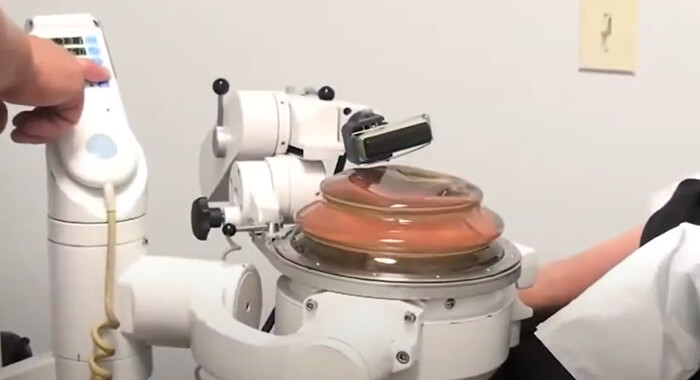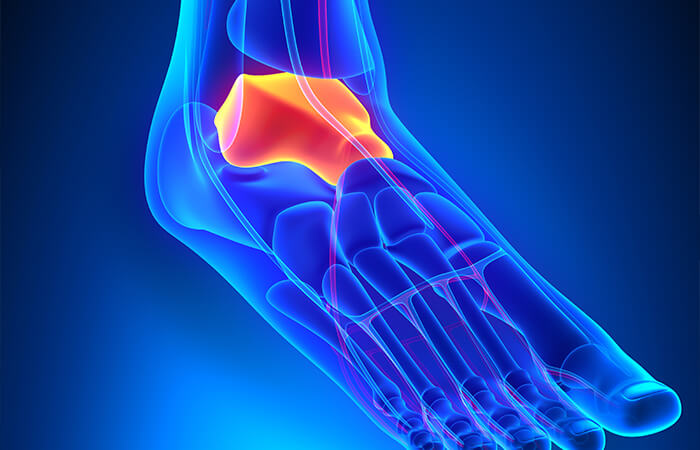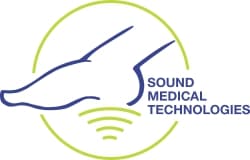Avascular Necrosis of the Talus Bone FAQs
ESWT Avascular necrosis of talus
What is avascular necrosis (AN)?
Avascular necrosis occurs when normally healthy tissue begins to die due to a lack of blood flow. The word “vascular” refers to blood vessels and blood circulation. The word “necrosis” means cell or tissue death. Avascular necrosis can occur anywhere in the body, but is found most often in bones with a poor blood supply. Specifically, our New York ESWT avascular necrosis patients usually present with AN of the talus bone of the foot. Avascular necrosis is always a serious condition requiring medical attention.

What are the signs and symptoms of avascular necrosis?
At first, there may be no symptoms at all. Many of our avascular necrosis talus Pittsburgh patients only learn they have AN during routine podiatry X-rays. The first symptoms usually felt are a generalized ankle pain, which typically becomes more constant as the disease progresses. Eventually the joint can be affected to the point where the bone collapses—this results in severe pain whenever the joint is used. As an extremely general rule, the time elapsed between the first feelings of pain and bone collapse ranges from 6 months to over a year.
What causes avascular necrosis?
Most patients don’t realize that bone is living tissue with a rich blood supply. Any time that the blood supply to a bone is decreased, avascular necrosis can occur. AN often occurs without an obvious cause, but is often associated with:
- Long term corticosteroid use (cortisone). Taken either orally or injected, cortisone use is associated with over 35% of all avascular necrosis cases.
- Sickle cell disease
- HIV infection
- Chemotherapy and radiation therapy for cancer
- Autoimmune diseases such as lupus

What is the talus bone?
The talus is one of the main bones of the ankle. It connects the leg bone (tibia) to the lower ankle—the dome of the talus is the round surface that the ankle joint pivots on. Most of the cases seen at Beaver Valley Foot Clinic involve the talus, but several of our Cranberry ESWT avascular necrosis patients have the condition in nearby ankle bones. Why does AN frequently occur at the talus? The talus is mostly covered in cartilage. Since cartilage has a poor blood supply, so does the underlying talus bone. Several of our ESWT avascular necrosis Bridgewater patients also present with AN of the cuboid and navicular bones, which unfortunately also generally have poor circulation.
How can ESWT (Extracorporeal Shockwave Therapy) treat avascular necrosis successfully?
Extracorporeal Shockwave Therapy (ESWT) is an excellent treatment for avascular necrosis—it’s unique, in fact. Remember that avascular necrosis is bone death due to lack of blood circulation. To date, Shockwave Therapy is the only treatment recognized to cause an effect called neo-vascularization (the formation of many new capillary arteries in the area). ESWT effectively uses high-intensity ultrasound energy to “jump-start” the healing process. We feel that several of our Butler ESWT avascular necrosis patients have been saved from surgery thanks to Shockwave therapy.
What Are The Symptoms Of Avascular Necrosis?
At the early stages of avascular necrosis you may not notice any symptoms at all, but as the times passes the condition will start getting worse and you will start noticing symptoms like pain in your joints.
When your condition is bad you may not be able to use your joint and may face unbearable pain while moving your joint. If this happens then it may be a sign of Avascular necrosis, visit your doctor if you experience such kind of symptoms.
Can avascular necrosis of the talus lead to arthritis?
Yes, avascular necrosis of the talus can potentially lead to arthritis. Avascular necrosis, also known as osteonecrosis, is the death of bone tissue due to a lack of blood supply. When the talus bone in the foot undergoes avascular necrosis, it can disrupt the normal functioning and integrity of the joint.
Avascular necrosis of the talus can cause the bone to collapse or become fragmented, leading to joint damage. As a result, the articular cartilage, which provides cushioning and allows smooth joint movement, can become damaged or eroded. The loss of healthy bone and cartilage can ultimately lead to the development of arthritis in the affected joint.
Arthritis refers to the inflammation and deterioration of a joint, leading to pain, stiffness, swelling, and restricted mobility. In the context of avascular necrosis of the talus, the arthritis that develops is typically termed post-traumatic arthritis, as it arises following an injury or damage to the talus bone.
The progression to arthritis can vary among individuals and may depend on factors such as the extent of avascular necrosis, the effectiveness of treatment, and the presence of additional risk factors. Early detection, appropriate treatment, and management strategies can help minimize the risk and impact of arthritis associated with avascular necrosis of the talus.
How long does the recovery process typically take for avascular necrosis of the talus?
The recovery process for avascular necrosis of the talus can vary depending on the severity of the condition, the treatment approach, and individual factors. It typically takes several months for initial healing, but complete recovery can take much longer. Non-surgical treatments may require a period of immobilization and restricted weight-bearing, followed by a gradual return to activity. Surgical interventions, such as core decompression or joint replacement, may involve a longer recovery period, often spanning several months to a year, including rehabilitation and physical therapy.
Who Are At A Risk Of Avascular Necrosis?
This condition is common most of the time and anyone can get it but there are some risk factors that make it more likely to happen to you, here are some of those factors:
- Aging
Being over 50 highly increased the chances of Avascular necrosis as after 50 your bones and joints start getting weak. They can’t work the way they used to and can be easily damaged.
- Injuries
Direct injuries on your joints or bones can be a really dangerous situation and this kind of situation are idea for Avascular necrosis to occur.
This is even more dangerous if your injury doesn’t receive a proper treatment, since this may worsen your situation and increase risks of Avascular necrosis in future.
- Some Type Of Treatments
Every kind of treatment has some side effects and these side effects can make you a patient of Avascular necrosis.
For example, the radiation therapies used for cancer can weaken your bones are put you at a risk of fractures or any other bone problems.
- Alcohol Or Smoking
Alcohol is already bad for your health especially because it doesn’t let’s your blood flow properly, if you consume alcohol on daily basis then you are preventing your bones from getting enough blood.
The same goes for smoking!
What other bones are frequent sites for avascular necrosis?
As mentioned, AN can occur anywhere in the body, but is most often encountered in bones with an already poor blood supply. These include the hip joint (femur), shoulder (scapula), knee joint, and sometimes even the jaw. AN in the hip joint is often associated with hip replacement surgery.
What are some other common treatments for avascular necrosis?
Typically only three procedures are used to treat AN of the talus. All are invasive, and complete ankle fusion is considered a major surgery. One of our main treatment goals for Pittsburgh talus ESWT patients is avoiding surgery.
Core decompression:
This procedure involves drilling a hole in the talus in an attempt to relieve pressure on the bone and therefore increase the blood supply. Note that this can only be used in the earliest stages of avascular necrosis.
Osteotomy:
The ankle joint is opened, and the talus is trimmed and repositioned in the hopes of relieving stress on the bone. As with complete fusion, this can be a major orthopedic surgery. This can be used for early to mid-stage AN.
Complete ankle fusion:
Much as it sounds, the irreparably damaged portions of bone are removed and the joint is fused. This effectively removes the joint and alters ankle function forever.
Does surgery work? How often is it successful?
Ankle surgery carries the same risks as any orthopedic surgery, anywhere else in the body. Remember, any surgery basically opens the skin and removes or otherwise alters tissues which are there to perform an important function. Here is a non-exhaustive list of potential problems resulting from surgery (open or arthroscopic).
- Infection
- Damage to ligaments and tendons of the ankle
- Scar tissue formation
- Nerve and blood vessel damage
- Surgical failure. If surgery doesn’t work as planned, more surgery may be needed. This is one of the most important reasons to avoid surgery if at all possible. Always look for less invasive options first
What should patients do if they experience worsening symptoms after ESWT treatment?
If patients experience worsening symptoms even after the ESWT treatment then it’s good for them to follow these steps:
- Contact healthcare provider
Immediately inform your doctor about the complications, it should be the one who did your ESWT treatment. Informing them can help them prepare and they may even give you some tips on what to do next.
- Describe your symptoms clearly
Provide detailed information about the nature of the worsening symptoms, including pain intensity, location, duration, and any associated symptoms like swelling or difficulty bearing weight.
- Follow Medical Advice:
Follow any instructions given by the healthcare provider, which may include rest, elevation of the affected foot, ice application (if recommended), and avoiding weight-bearing activities.
Is ESWT suitable for all stages of avascular necrosis of the talus?
The duration of effects from Extracorporeal Shock Wave Therapy (ESWT) for avascular necrosis (AVN) of the talus can vary depending on several factors, including the severity of the condition, the patient’s response to treatment, and adherence to post-treatment care. Typically:
- Immediate Effects: Some patients may experience immediate pain relief or improvement in symptoms shortly after ESWT treatment sessions.
- Short-Term Effects: The initial effects of ESWT may last for several weeks to months post-treatment. During this time, patients may notice reduced pain, improved mobility, and better function of the affected foot.
- Maintenance Therapy: Depending on the individual response and progression of AVN, maintenance ESWT sessions or other treatments may be recommended to prolong the benefits of the initial treatment.
- Combination Therapy: ESWT is often used in conjunction with other treatments such as physical therapy, medications, or surgical interventions for optimal management of AVN.
- Monitoring and Follow-Up: Regular monitoring and follow-up with healthcare providers are essential to assess the ongoing effectiveness of ESWT and to make adjustments to the treatment plan as needed.
What Should I Expect During an ESWT session for AVN of Talus?
The only things you can to during an ESWT treatment are preparation and anesthesia, here’s how they go:
- Anesthesia: Although completely optional, you will be given an anesthesia depending on the intensity of the treatment and your tolerance level. You should expect local anesthesia, or mild sedative but remember as mentioned earlier, most ESWT treatments are done without an anesthesia.
- Preparation: The doctors will ask you go lie down while your affected ankle will be kept exposed and accessible to the doctors for the procedure. Next, they may clean the area and apply gel on it to help conduct shockwaves.
How Long Does The Effects Of ESWT Last in Patients With AVN Talus?
The effects vary from patients to patients, but it mostly depends on the severity. Here’s how the effects look in a general timeline:
- Short-term effects: After ESWT, you may experience initial pain relief that will come with reduction of symptoms, you will see these changes within few day to weeks. However, since the main goal of ESWT is providing a long-term healing and bone regeneration, this is going to take a longer time.
- Mid-term effects: After at least 3-6 months you will start noticing some permanent and clear results of ESWT, which can include changes like bone tissues begging to heal and regenerate. You are likely to experience gradual improvement in pain, and mobility as well which can make walking easier.
- Long-term effects: Fortunately, many patients experience the effects of ESWT for months to years, as it helps the body slowdown the progression of AVN. Which allows you to avoid serious and more invasive treatments like surgery. But remember, the effects vary from person to person and some might need additional treatments for better results!
Sound Medical Technologies, Inc. owns and operates some of the rare mobile Extracorporeal Shockwave Therapy (“ESWT” ) machines in Pennsylvania and Eastern Ohio. We understand the importance of sensible and effective practice management. Our company is devoted to making ESWT convenient and easy to perform within your office or facility setting. We operate FDA approved Dornier Epos Ultra’s which are ultrasound guided allowing you to see the inflammation within the body and treat it precisely.
Sound Medical Technologies, Inc. offers several ESWT– related services. We provide trained staff and certified technicians to operate the equipment during ESWT procedures. Physician certifications, recommendations and our clinical applications specialist can answer all your questions.
